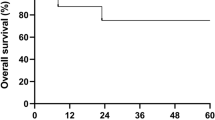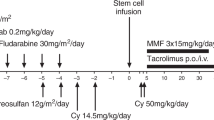Abstract
Graft rejection is a common problem after alternative donor transplantation for patients with refractory severe aplastic anemia (SAA). Intensification of the conditioning regimen, with the inclusion of irradiation, has often been advocated to combat this problem. With this approach engraftment rate improved, but the incidence of transplant-related complications is also increased, resulting in little change in the overall outcome. We investigated the use of the combination of fludarabine, cyclophosphamide and anti-thymocyte globulin as the conditioning regimen in five multiply-transfused SAA patients. Three patients received an HLA one-antigen disparate related donor transplant, while two patients were given marrow from matched, unrelated donors. The regimen was well tolerated, with only grade I toxicity encountered. With a median follow-up of 9 months, all patients are alive with complete donor chimerism. We conclude that fludarabine may be used in place of irradiation to augment the conditioning regimen of cyclophosphamide and anti-thymocyte globulin for alternative donor transplantation in children with SAA. Bone Marrow Transplantation (2001) 27, 125–128.
This is a preview of subscription content, access via your institution
Access options
Subscribe to this journal
Receive 12 print issues and online access
$259.00 per year
only $21.58 per issue
Buy this article
- Purchase on Springer Link
- Instant access to full article PDF
Prices may be subject to local taxes which are calculated during checkout
Similar content being viewed by others
References
Wagner JL, Deeg HJ, Seidel K et al. Bone marrow transplantation for severe aplastic anemia from genotypically HLA-nonidentical relatives: an update of the Seattle experience Transplantation 1996 61: 54–61
Bacigalupo A, Schrezenmeier H, Hows J et al. Treatment of acquired severe aplastic anemia for the EBMT Working Party on SAA Int J Pediatr Hematol Oncol 1997 4: 267–274
Deeg HJ, Seidel K, Casper J et al. Marrow transplantation from unrelated donors for patients with severe aplastic anemia who have failed immunosuppressive therapy Biol Blood Marrow Transplant 1999 5: 243–252
Bacigalupo A, Bland R, Oneto R et al. Treatment of acquired severe aplastic anemia: bone marrow transplantation compared with immunosuppressive therapy - the European Group for Blood and Marrow Transplantation experience Semin Hematol 2000 37: 69–80
Gaziev D, Giardini C, Galimberti M et al. Bone marrow transplantation for transfused patients with severe aplastic anemia using cyclophosphamide and total lymphoid irradiation as conditioning therapy: long-term follow-up from a single center Bone Marrow Transplant 1999 24: 253–257
Kojima S, Inaba J, Kondo M et al. Unrelated donor marrow transplantation for severe acquired aplastic anemia using cyclophosphamide, antithymocyte globulin, and total body irradiation Blood 1995 85: 291–292
Deeg HJ, Schoch G, Ramsay N et al. Marrow transplantation from unrelated donors for patients with aplastic anemia who failed immunosuppressive therapy Blood 1997 90: 397a (Abstr. 1763)
Champlin RE, Horowitz MM, van Bekkum DW et al. Graft failure following bone marrow transplantation for severe aplastic anemia: risk factors and treatment results Blood 1989 73: 606–613
Gluckman E, Horowitz MM, Champlin RE et al. Bone marrow transplantation for severe aplastic anemia. Influence of conditioning regimen and graft-versus-host disease prophylaxis regimens on outcome Blood 1992 79: 269–275
Giralt S, Estey E, Albitar M et al. Engraftment of allogeneic hematopoietic progenitor cells with purine analog-containing chemotherapy: harnessing graft-versus-leukemia without myeloablative therapy Blood 1997 89: 4331–4336
Slavin S, Nagler A, Naparstek E et al. Non-myeloablative stem cell transplantation and cell therapy as an alternative to conventional bone marrow transplantation with lethal cytoreduction for the treatment of malignant and nonmalignant hematological diseases Blood 1998 91: 756–763
Bearman SI, Appelbaum FR, Buckner CD et al. Regimen-related toxicity in patients undergoing bone marrow transplantation J Clin Oncol 1998 6: 1562–1568
Margolis DA, Casper JT . Alternative-donor hematopoietic stem-cell transplantation for severe aplastic anemia Semin Hematol 2000 37: 43–55
Margolis D, Camitta B, Pietryga D et al. Unrelated donor bone marrow transplantation to treat severe aplastic anemia in children and young adults Br J Haematol 1996 94: 65–72
Deeg HJ, Amylon M, Harris R et al. Marrow transplantation from unrelated donors for patients with aplastic anemia (AA) – optimization of a conditioning regimen Blood 1999 94: 713a
Socie G, Henry-Amar M, Cosset JM et al. Increased incidence of solid malignant tumors after bone marrow transplantation for severe aplastic anemia Blood 1991 78: 277–279
Deeg HJ, Anasetti C, Petersdorf E et al. Cyclophosphamide plus ATG is insufficient for sustained hematopoietic reconstitution in patients with severe aplastic anemia transplanted with marrow from HLA-A, B, DRB matched unrelated donors Blood 1994 83: 3417–3418
Abella E, Karanes C, Klein J et al. Superior results following matched unrelated donor bone marrow transplants in severe aplastic anemia patients using a non-TBI containing preparative regimen Proc IBMTR/ASBMT Meet 1999 44 (Abstr. O1)
Khouri IF, Keating M, Korbling M et al. Transplant-lite: induction of graft-versus-malignancy using fludarabine-based nonablative chemotherapy and allogeneic blood progenitor-cell transplantation as treatment of lymphoid malignancies J Clin Oncol 1998 16: 2817–2824
Bacigalupo A, Van Lint MT, Lamparelli T et al. Alternate donor transplants for aplastic anemia: unmanipulated bone marrow following conditioning with fludarabine, cyclophosphamide and anti-thymocyte globulin Bone Marrow Transplant 1999 23: (Suppl. 3) S70 (Abstr. 226)
Stucki A, Leisenring W, Sandmaier BM et al. Decreased rejection and improved survival of first and second marrow transplants for severe aplastic anemia (a 26-year retrospective analysis) Blood 1998 92: 2742–2749
Author information
Authors and Affiliations
Rights and permissions
About this article
Cite this article
Chan, K., Li, C., Worth, L. et al. A fludarabine-based conditioning regimen for severe aplastic anemia. Bone Marrow Transplant 27, 125–128 (2001). https://doi.org/10.1038/sj.bmt.1702768
Received:
Accepted:
Published:
Issue Date:
DOI: https://doi.org/10.1038/sj.bmt.1702768
Keywords
This article is cited by
-
A combination of fludarabine, half-dose cyclophosphamide, and anti-thymocyte globulin is an effective conditioning regimen before allogeneic stem cell transplantation for aplastic anemia
International Journal of Hematology (2014)
-
A novel protocol for haploidentical hematopoietic SCT without in vitro T-cell depletion in the treatment of severe acquired aplastic anemia
Bone Marrow Transplantation (2012)
-
Disease-specific hematopoietic cell transplantation: nonmyeloablative conditioning regimen for dyskeratosis congenita
Bone Marrow Transplantation (2011)
-
Is it time for a change? The case for early application of unrelated allo-SCT for severe aplastic anemia
Bone Marrow Transplantation (2010)
-
Risk-adapted procedures for HSCT from alternative donor in children with severe aplastic anaemia
Bone Marrow Transplantation (2008)



